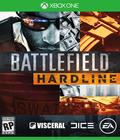Battlefield Hardline is set for release in less than a week, but we wanted to jump into the multiplayer side a little early, so I spent the last two days visiting EA headquarters in Redwood City, playing multiplayer with roughly 30 other critics. Because the retail servers weren't available, EA had us all playing on a local LAN with a custom Battlefield Hardline server. We got to see all of the game modes but didn't experience the matchmaking interface or character progression. Every time the EA admin reset the custom server, all character progress was wiped. As a result, you shouldn't think of these as final impressions (those will be in the review next week) but rather as an overview of what to expect when you head online.
Modes
There are seven different game types that are spread across nine different maps in Battlefield Hardline. Five of the game modes (Blood Money, Crosshair, Heist, Hotwire and Rescue) are new, while Conquest and Team Deathmatch should be familiar to series veterans.
Blood Money
Blood Money is an intriguing variant on capture-the-flag style gameplay. Instead of a single flag, though, money is treated as a fungible resource. For the cops, it's evidence. For the criminals, it's loot. There is a central money pile in the map, which both sides are vying to control. Each player can collect up to 10 bills at a time before running back to the base and depositing the cash into the vault.
What makes Blood Money work is the extra twist of insecure vaults. If the opposing team gains a lead, there's nothing stopping you from ignoring the central money pile and simply stealing straight from the other side's vault. This dynamic works exceedingly well when the server is fully populated, as multiple squads are each working on different tasks. Coordination is key if you want to dominate in Blood Money.
Crosshair
Crosshair boils down to "protect the VIP." Since Crosshair is a 5v5 mode, the available maps are played with a reduced area to keep things focused. On the one hand, our matches tended to run fairly quickly. On the other, it was usually because the VIP made a beeline for one of the extraction points, and that was it. As the second day wore on, Crosshair matches started to last a little longer, but the advantage was alway with the team protecting the VIP.
Heist
Heist mode is a focused "attack/defend" game type. One team is responsible for breaking into two different vaults and then getting the contents to two different extraction points. It sounds simple enough, but the multiple locations for both contents and extraction made for some fun gameplay. The first part of the mode (breaking into the vaults) never took long, but getting the goods out was often down to the wire. Heist is a great mode to use gadgets like the grappling hook and zip line, as alternate paths are your best friend here.
Hotwire
Yes, you have guns in Hotwire. No, shooting people isn't the ultimate goal. I mean, yes, it can help you slow down your opponents, but ultimately, kills don't have that much effect in Hotwire. Here, it's all about stealing cars and driving fast. To win, your team must capture as many of the five "key" cars as possible on the map and drive them around. Think of them as mobile command points. So long as you keep moving (and have control of more cars than the other team), you'll stay in the lead.
Hotwire was an early favorite of mine (though it eventually lost out to Heist and Blood Money) since the focus on vehicle action really changed up the pace of gameplay. Unfortunately, Hotwire falters when it comes to vehicle damage. Yes, you can shoot a car to blow it up (destroyed cars reset to their original positions), but ramming a vehicle head-on does little more than sound a "thud" and result in the occasional clipping. Being able to take out others vehicle-to-vehicle would have added a strategic layer to the game.
Rescue
Rescue feels somewhat like Heist, except instead of trying to steal packages, you're either trying to rescue a hostage or keep the police away from the hostages for a certain amount of time. Whereas Heist was all about the "attack" part of "attack/defend" play, Rescue focuses on the "defend" part. The two modes felt like two sides of the same coin, so which you prefer will likely rest on which style of gameplay you favor.
Conquest
Like Blood Money, Conquest caters to big maps with lots of players. You can get into intimate firefights, but the bulk of the action during our sessions had multiple person firefights going on almost constantly. Because of the map size, Conquest also encourages vehicle play. If you're doing it all on foot, you're doing it wrong.
Team Deathmatch
After playing the other modes, Team Deathmatch actually felt kind of ... boring. It's almost a requirement to have this in multiplayer shooters these days, but after seeing it in so many games (and going through all the other modes back-to-back), there didn't seem to be much reason to play it, unless you're going solo and trying to kill some time.
Maps
The maps available for play included all nine from the final game. Some will be familiar to players who checked out the open beta, and the rest are new.
An important thing to note on the maps: All of them include many small points of destruction (doors, walls, etc.). This means that in addition to the standard paths, it is possible to create new alternate paths simply by breaching a wall. There are also scripted bits that offer larger changes (similar to what was seen in Battlefield 4). Map size also changes based on the game mode selected. On smaller modes, the "out of bounds" area on the maps is pulled in closer, forcing players to keep to the action.
Bank Job
Set in a high-end city bank, Bank Job felt like something out of a movie set. Not only was the bank like a maze, but multiple paths around the outside (including on the roof) provided for plenty of escape options (or entry points, if you're playing Rescue).
The Block
This is a low-income suburban neighborhood, complete with a slumlord-style apartment block and a diner. The homes make for great cat-and-mouse, as most of the internal walls can be blown. On the outer edges of the map, various vehicles are permanently placed, providing multiple, natural cover points.
Derailed
If you ever wanted to fight it out in the L.A. flood control channels like John Connor in "Terminator 2," then this is your map. Team bases are on either side, regular road bridges cross over the concrete channel, and a railroad trestle high above provides a central sniper's nest. At first glance, Derailed doesn't look like much, but you'll come to appreciate it after a few rounds of Blood Money.
Downtown
Based on Downtown L.A., this was probably my least favorite map on rotation. There are multiple bridges and plenty of room to maneuver, but the design didn't really stand out. Most of the maps had a solid hook that defined them, but the best I can say about Downtown at this point is that it felt ... generic.
Dust Bowl
Set in a desert town, Dust Bowl is large and littered with interesting buildings (the firefights in the central motel's courtyard were intense). At certain points, a massive dust storm rolls in, obscuring most of your view. With minimal visibility, tactics and team communication become more important than ever. We didn't have voice chat available while playing at EA, but it's obvious that a coordinated team will own this map.
Everglades
Conquest. In the Florida Everglades. With airboats. And choppers. What could possibly go wrong? Pretty much nothing (or everything). Everglades is large and open, with three distinct sections providing a natural separation for Conquest. Figuring out how to get back and forth in an airboat was half the fun, as was attacking the central area with an attack chopper. Really, the only thing missing was the banjo soundtrack.
Growhouse
It's a marijuana factory. Narrow and long, with multiple levels, Growhouse rewards players with situational awareness. You can't really run-and-gun when you're inside here. Recon is the name of the game.
Hollywood Heights
L.A.'s luxury homes are in the Hollywood Heights, and you get to shoot them up while a brush fire burns in the background. The hook with Hollywood Heights is the vertical movement on the map. The central house has multiple levels, and the hills also create opportunity for vertical movement. Savvy use of the zipline to make a quick exit can mean the difference between winning and losing while fighting in the lap of luxury.
Riptide
Of all nine maps, Riptide is my overall favorite. While others may excel at a particular mode, Riptide feels like the "jack of all trades" when it comes to the map selection. No matter which mode we played on it, the map had something to offer. It always felt balanced; there were options for air, land and water vehicles; and quite simply, it just looks good. The visual palette of blues, greens and whites makes the whole thing look clean and fresh, even while it's getting shot up.
Gameplay
Even though we were playing on a LAN, EA didn't have mics set up on any of the headsets. This meant that any coordination was an accidental happenstance (e.g., when two of us sitting by each other realized we'd been placed on the same team). For the most part, everyone played solo, and while it worked, it was sorely obvious that going at it solo is not the way to play Battlefield Hardline's multiplayer.
All of the game modes, with the exception of Team Deathmatch, are built around the idea of a coordinated team that strategizes and works together. On the larger maps, this is reinforced with the concept of four different strike teams. Each team can do its own thing, and downed team members can respawn at either their home base or right alongside a team member.
For Blood Money or Conquest, having the strike teams coordinate would result in some impressive action. In Blood Money, one team could defend the home vault, while another went to harass the enemy vault. The two remaining teams could steal the loot, with one keeping lookout, while the other did the actual stealing. In Conquest, three of the teams could each attack a control point, while the fourth patrolled the skies in the chopper. The chopper got a lot of grief during our play session, but that was mostly due to the inexperience with flying. Once you get the hang of the chopper (and have two solid gunners on board), the thing is a beast.
Battlefield Hardline also builds on Battlefield 4's commander mode. Done entirely in-game, each side is allowed to have a hacker. The hacker can "hack" hot spots on the map (such as security cameras) to provide a limited view area for his team. Any enemies within the view will be visible on the minimap. Boosts, such as fast deploy, can be provided to individual strike teams by the hacker, and friendly soldiers can also be temporarily cloaked from the opposing team's minimap, so long as they stay within a small area.
When two hackers are playing, they can counter each other's hacks, so it becomes something of a cat-and-mouse game for visibility of the playing field. The hacker can also highlight specific targets on the map, providing strategic direction for each strike team.
There is no app for the hacker mode, which means you have to play it with a standard controller; you can't used a linked tablet. This is a mixed blessing due to the control setup. For some reason, the hacker's cursor is only capable of "smart hopping" from target to target. It sounds good in theory, but it quickly breaks down when there is a lot of action on the map. Hopefully, this is something the development team can tweak in a patch because the hacker mode is otherwise a nifty concept. It also has the potential to be a good way for a casual gamer friend to join in the fun.
At this point, the big questions around Battlefield Hardline's multiplayer are around performance and matchmaking. Since the environment at EA was so controlled, it wasn't a good benchmark. To get a real feel for how the production environment handles things, I'll be jumping online this upcoming weekend with a retail copy of the game. Players on Xbox One can also check it out for themselves via EA Access. All subscribers currently have access to the entire Battlefield Hardline multiplayer mode.
Be sure to check back next week for the final verdict.
More articles about Battlefield: Hardline










 Battlefield: Hardline switches the franchise standard of military themed action for a more urban environment with the player taking part in a police-oriented adventure.
Battlefield: Hardline switches the franchise standard of military themed action for a more urban environment with the player taking part in a police-oriented adventure.

















































